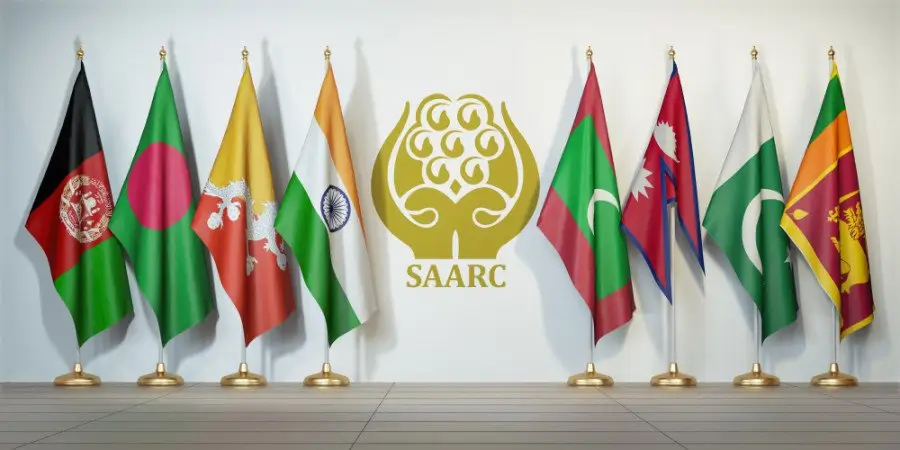The South Asian Association for Regional Cooperation (SAARC) was established in 1985 with the aim of fostering regional cooperation and development among its member countries. However, this organization has been plagued by political and historical tensions, particularly between its two largest members, India and Pakistan. Since their partition in 1947, the relationship between the two states has been characterized by political animosity, security concerns, and territorial disputes. Undoubtedly, many efforts have been made to promote peace and cooperation, but progress has often been hindered by ongoing issues, tensions, and deep-rooted historical grievances.
Despite these challenges, SAARC has the potential to play a crucial role in promoting friendly relations between Pakistan and India. The SAARC platform allows these two neighboring states to build trust, engage in constructive dialogue, and address common challenges, despite their historical and political differences. India and Pakistan can pave the way for a more peaceful and prosperous South Asia by leveraging SAARC’s framework. This article aims to explore the key opportunities and challenges that need to be addressed to bridge the gap between the two nations and unlock the organization’s true potential.
Numerous opportunities could be harnessed by India and Pakistan through SAARC. For instance, this organization provides a platform for India and Pakistan to resolve their problems by engaging in dialogue on different issues. Various summits, conferences, and regular meetings offer golden opportunities for leaders from both states to interact and discuss matters of mutual interest. SAARC can play a pivotal role in facilitating a favorable environment between India and Pakistan for resolving differences, fostering understanding, and building trust through diplomatic channels and open communication.
Moreover, both countries share common challenges such as poverty, terrorism, climate change, and economic development issues. By working together through this platform, these countries can address these issues by pooling their resources, expertise, and knowledge. Furthermore, collaborative efforts can lead to the formulation of comprehensive strategies to promote prosperity and regional stability.
Cultural exchanges and people-to-people interactions can eliminate misconceptions and promote understanding.
SAARC can also play an important role in enhancing economic cooperation between India and Pakistan. Through infrastructure development, investments, and trade, positive interdependence can be created, ultimately benefiting both nations. In addition to this, SAARC can catalyze economic integration by reducing trade barriers, promoting regional connectivity, and encouraging people-to-people exchanges, which could further improve relations between the two states. Cultural festivals, sports activities, academic exchanges, and tourism projects can foster mutual understanding, encourage tolerance, and eliminate misconceptions. Such interactions allow residents from both countries to understand their shared history and build personal connections, contributing to a more positive image of each other.
SAARC can also play a crucial role in enabling confidence-building measures (CBMs) between Pakistan and India. These CBMs can include mutual efforts to combat terrorism, reduce poverty, conduct joint military exercises, cooperate on disaster management across borders, and share intelligence. These measures help reduce tensions, build trust, and promote peace and cooperation. Subsequently, SAARC offers a stage for Track-II diplomacy, allowing non-governmental organizations, scholars, intellectuals, researchers, and civil society associations from the two nations to participate in productive discourse. Track-II initiatives can help build confidence, generate new ideas, and encourage different points of view on contentious issues. Engagements of this kind have the potential to change public opinion and foster an atmosphere that encourages dialogue and reconciliation.
Apart from these opportunities, there are some key challenges that need to be addressed to foster cooperation between the two neighboring states using SAARC’s platform. For instance, the longstanding Kashmir dispute is a bone of contention between Pakistan and India. Therefore, the two states should make collective efforts to resolve the issue, recognizing the aspirations of the Kashmiri people while respecting each other’s concerns.
Moreover, deep-rooted mistrust between India and Pakistan hampers meaningful cooperation within SAARC. However, sustained efforts and a genuine commitment to resolving differences are required from both sides to build trust. Tensions can sometimes escalate between India and Pakistan due to external geopolitical influences from global powers. Both countries must avoid getting entangled in proxy conflicts and be mindful of their regional interests.
Additionally, it’s crucial to strike a balance between bilateral discussions and global venues like SAARC. While bilateral discussions are essential for resolving particular problems, SAARC offers a more extensive framework for wider regional cooperation.
Hitherto, the South Asian Association for Regional Cooperation (SAARC) has offered India and Pakistan the opportunity to overcome historical differences and chart a path towards peace, stability, and prosperity. By taking advantage of the framework provided by SAARC, the two countries can engage in constructive dialogue, address common challenges, strengthen economic cooperation, and promote cultural exchanges. Collective efforts within SAARC can gradually build trust, eliminate misconceptions, and create a favorable environment for improving India-Pakistan relations. It is through unwavering commitment, mutual respect, and a willingness to resolve differences peacefully that SAARC can unleash its true potential and bring lasting peace to South Asia.








